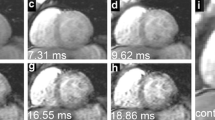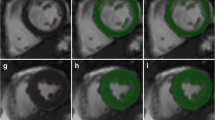Abstract
Purpose: To evaluate six algorithms for segmenting non-viable left ventricular (LV) myocardium in delayed enhancement (DE) magnetic resonance imaging (MRI). Methods: Twenty-three patients with known chronic ischemic heart disease underwent DE-MRI. DE images were first manually thresholded using an interactive region-filling tool to isolate non-viable myocardium. Then, six thresholding algorithms, based on the image intensity characteristics of either LV blood pool (BP), viable LV myocardium, or both, were applied to each image. For the Mean−2SDBP algorithm, thresholds were equal to the mean BP intensity minus twice its standard deviation. For the Mean+2SDSemi, Mean+3SDSemi, Mean+2SDAuto, and Mean+3SDAuto algorithms, thresholds equaled the mean intensity of viable myocardium plus twice (or thrice, as denoted by the name) the standard deviation of intensity (subscripts denote how these values were determined: automatic or semi-automatic). For the Minimum Intensity algorithm, the threshold equaled the minimum intensity between the BP and LV myocardium mean intensities. Percent Scar was defined as the ratio of non-viable to total myocardial pixels in each image. Agreement between each algorithm and manual thresholding was assessed using Bland–Altman analysis. Results: Mean Percent Scar was 25 ± 16% by manual thresholding. Five of the six algorithms demonstrated mean bias within ±3% (all except Mean+2SDAuto); however, limits of agreement (LoA) were large in general (range 12–36%). The best overall agreement was demonstrated by the Mean+2SDSemi (bias, 0%; LoA, 12%) and Mean+3SDSemi(bias, −3%; LoA, 14%) algorithms. Conclusion: On average, five of the six algorithms proved satisfactory for clinical implementation; however, in some images, manual correction of automatic results was necessary.
Similar content being viewed by others
References
AE Stillman N Wilke M. Jerosch-Herold (1999) ArticleTitleMyocardial viability Radiol Clin North Am 37 361–378 Occurrence Handle1:STN:280:DyaK1M3hsVylsw%3D%3D Occurrence Handle10198648
JJ Bax A Roos Particlede EE. Wall Particlevan der (1999) ArticleTitleAssessment of myocardial viability by MRI J Magn Reson Imaging 10 418–422 Occurrence Handle1:STN:280:DyaK1Mvjsl2hug%3D%3D Occurrence Handle10508304
KM Choi RJ Kim G Gubernikoff JD Vargas M Parker RM. Judd (2001) ArticleTitleTransmural extent of acute myocardial infarction predicts long-term improvement in contractile function Circulation 104 1101–1107 Occurrence Handle1:STN:280:DC%2BD3Mvpt12jsg%3D%3D Occurrence Handle11535563
RJ Kim E Wu A Rafael et al. (2000) ArticleTitleThe use of contrast-enhanced MRI to identify reversible myocardial dysfunction New Engl J Med 343 1445–1453 Occurrence Handle1:STN:280:DC%2BD3M%2FisFWnsw%3D%3D Occurrence Handle11078769
E Wu RM Judd JD Vargas FJ Klocke RO Bonow RJ. Kim (2001) ArticleTitleVisualisation of presence, location, and transmural extent of healed Q-wave and non-Q-wave myocardial infarction Lancet 357 21–28 Occurrence Handle1:STN:280:DC%2BD3M7gtV2huw%3D%3D Occurrence Handle11197356
C Klein SG Nekolla FM Bengel et al. (2002) ArticleTitleAssessment of myocardial viability with contrast-enhanced magnetic resonance imaging: comparison with positron emission tomography Circulation 105 162–167 Occurrence Handle11790695
RJ Kim DS Fieno TB Parrish et al. (1999) ArticleTitleRelationship of MRI delayed contrast enhancement to irreversible injury, infarct age and contractile function Circulation 100 1992–2002 Occurrence Handle1:STN:280:DC%2BD3c%2FivVensg%3D%3D Occurrence Handle10556226
DS Fieno RJ Kim EL Chen JW Lomasney FJ Klocke RM. Judd (2000) ArticleTitleContrast-enhanced magnetic resonance imaging of myocardium at risk J Am Coll Cardiol 36 1985–1991 Occurrence Handle1:STN:280:DC%2BD3M%2FkvFajtA%3D%3D Occurrence Handle11092675
JJW Sandstede C Lipke M Beer et al. (2000) ArticleTitleAnalysis of first-pass and delayed contrast-enhancement patterns of dysfunctional myocardium on MR imaging: use in the prediction of myocardial viability AJR 174 1737–1740 Occurrence Handle1:STN:280:DC%2BD3czgt1Whtw%3D%3D Occurrence Handle10845515
RM Setser DG Bexell TP O’Donnell et al. (2003) ArticleTitleQuantitative assessment of myocardial scar in delayed-enhancement magnetic resonance imaging J Magn Reson Imaging 18 434–441 Occurrence Handle14508780
BL Gerber CE Rochitte DA Bluemke et al. (2001) ArticleTitleRelation between Gd-DTPA contrast enhancement and regional inotropic response in the periphery and center of myocardial infarction Circulation 104 998–1004 Occurrence Handle1:STN:280:DC%2BD3MvotV2nuw%3D%3D Occurrence Handle11524392
BL Gerber J Garot DA Bluemke KC Wu JAC. Lima (2002) ArticleTitleAccuracy of contrast-enhanced magnetic resonance imaging in predicting improvement of regional myocardial function in patients after acute myocardial infarction Circulation 106 1083–1089 Occurrence Handle12196333
H Marholdt A Wagner TA Holly et al. (2002) ArticleTitleReproducibility of chronic infarct size measurement by contrast-enhanced magnetic resonance imaging Circulation 106 2322–2327 Occurrence Handle12403661
HB Hillenbrand RJ Kim MA Parker DS Fieno RM. Judd (2002) ArticleTitleEarly assessment of myocardial salvage by contrast-enhanced magnetic resonance imaging Circulation 102 1678–1683
OP Simonetti RJ Kim DS Fieno et al. (2001) ArticleTitleAn improved MR imaging technique for the visualization of myocardial infarction Radiology 218 215–223 Occurrence Handle1:STN:280:DC%2BD3MzitFCntg%3D%3D Occurrence Handle11152805
P Kellman AE Arai ER McVeigh A. Aletras (2002) ArticleTitlePhase-sensitive inversion recovery for detecting myocardial infarction using gadolinium delayed hyperenhancement Magn Reson Med 47 372–383 Occurrence Handle11810682
JM Bland DG. Altman (1986) ArticleTitleStatistical methods for assessing agreement between two methods of clinical measurement Lancet 1 307–310 Occurrence Handle1:STN:280:BimC3MjhvFc%3D Occurrence Handle2868172
Samuels ML, Witmer JA. The normal distribution. In: Statistics for the Life Sciences. Prentice Hall, 1999; 500–559.
BL Gerber CE Rochitte JA Melin et al. (2000) ArticleTitleMicrovascular obstruction and left ventricular remodeling early after acute myocardial infarction Circulation 101 2734–2741 Occurrence Handle1:STN:280:DC%2BD3czhtFensw%3D%3D Occurrence Handle10851212
Author information
Authors and Affiliations
Corresponding author
Rights and permissions
About this article
Cite this article
Kolipaka, A., Chatzimavroudis, G.P., White, R.D. et al. Segmentation of non-viable myocardium in delayed enhancement magnetic resonance images. Int J Cardiovasc Imaging 21, 303–311 (2005). https://doi.org/10.1007/s10554-004-5806-z
Received:
Accepted:
Issue Date:
DOI: https://doi.org/10.1007/s10554-004-5806-z




